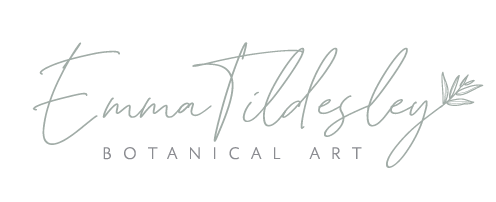If you find beauty in nature and want to preserve it on paper, Botanical Art may be the perfect creative adventure for you. Unlike other art forms, Botanical Illustration combines artistic expression with meticulous scientific precision. It requires careful observation, attention to detail and a true love for the delicate features of plants.
Why Choose Botanical Art?
Botanical Illustration has a rich history, closely tied to science and botany. It blends careful detail with a mindful, relaxing and creative process. The act of drawing or painting plants allows us to slow down, observe and truly appreciate the beauty of the natural world.
Art in any form is meditative and fulfilling for the soul. After a long day, sitting down to create something beautiful can be truly rewarding.
Essential Supplies
With so many materials and techniques available, getting started can feel overwhelming. Below, I’ve simplified the process and included my tried-and-true essentials for both watercolour and coloured pencil botanical illustration.
General Tools
- Hot Pressed Paper (I use St Cuthberts Mill)
- Cork-backed Metal Ruler
- Magnifying Glass
Watercolour Essentials
- Watercolour paints
- Brushes (round brushes in a few sizes are great starters)
- Mixing palette
- Two water jars (one for clean water, one for rinsing)
- Pencil (HB or 2H)
- Eraser
- Paper towel
Coloured Pencil Essentials
- Coloured pencils (Faber-Castell Polychromos are my go-to)
- Blending stump
- Pencil sharpener (manual crank sharpeners are reliable and gentle)
- Eraser
Choosing Your First Subject
With so many beautiful flowers, fruits, and leaves to choose from, it’s easy to feel stuck at the start. Here’s how to make it simpler:
- Choose something you personally find interesting or beautiful as this keeps the process enjoyable.
- Start with subjects that have a simple structure, such as single leaves, berries, or fruits. Check out my book Draw in 10 Minutes: Botanicals for ideas.
- Once you build confidence, explore more intricate forms like roses, orchids, or dahlias.
Learning Techniques, Tips, and Tricks
There’s a wealth of resources available for learning botanical art. Whether you prefer books, online videos, or dedicated learning platforms, there’s something for every style and pace of learning.
I offer a growing library of tutorials on my Patreon channel, where I share step-by-step guidance, material recommendations, and insights from my years of experience.
YouTube is also a great free resource with a wide variety of beginner-friendly content.
Practice and Enjoy the Process
Above all, enjoy the journey. Botanical Illustration is as much about observation and patience as it is about drawing. Nature offers endless inspiration, right outside your window or in your local park.
With each subject, your skills will grow. Don’t rush as slow, steady progress is what botanical art is all about.
Want to Learn More?
Join me on Patreon for:
- Exclusive video tutorials
- In-depth supply lists
- Step-by-step project guides
- Personal insights and community support
Let’s work together to grow in your botanical journey. http://patreon.com/emmatildesley


I loved this read! Your passion and clear understanding shines through. As an art newbie, this has given me some wonderful advice. Thank you for sharing Emma!
Thank you so much for commenting Mia. Be sure to stick around for more blog posts like this!